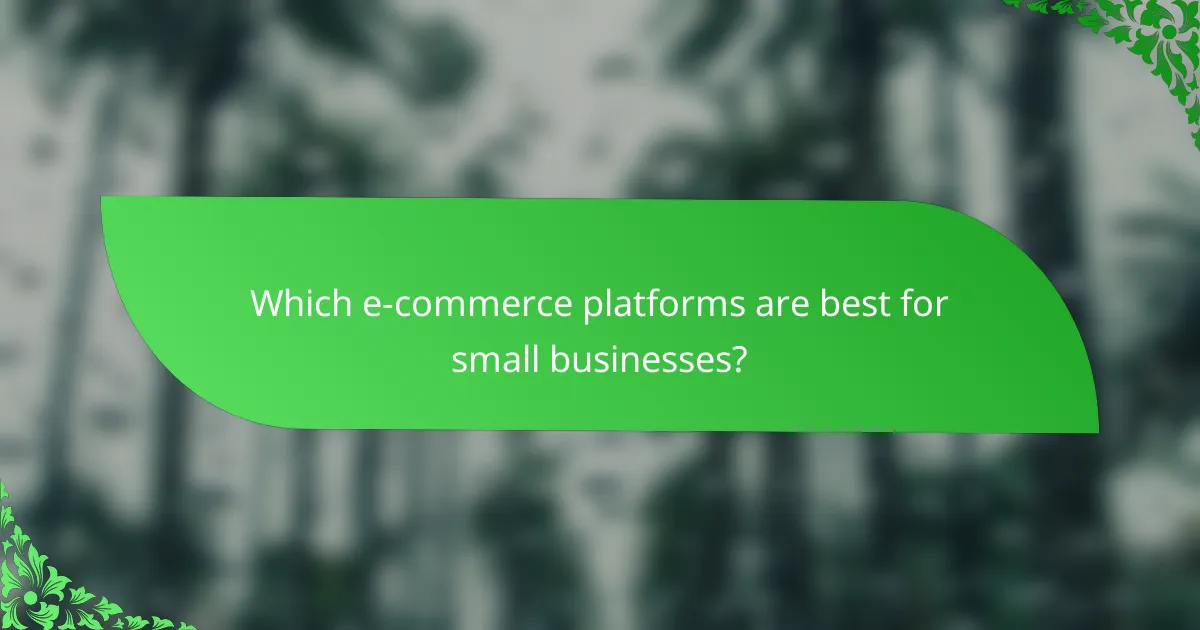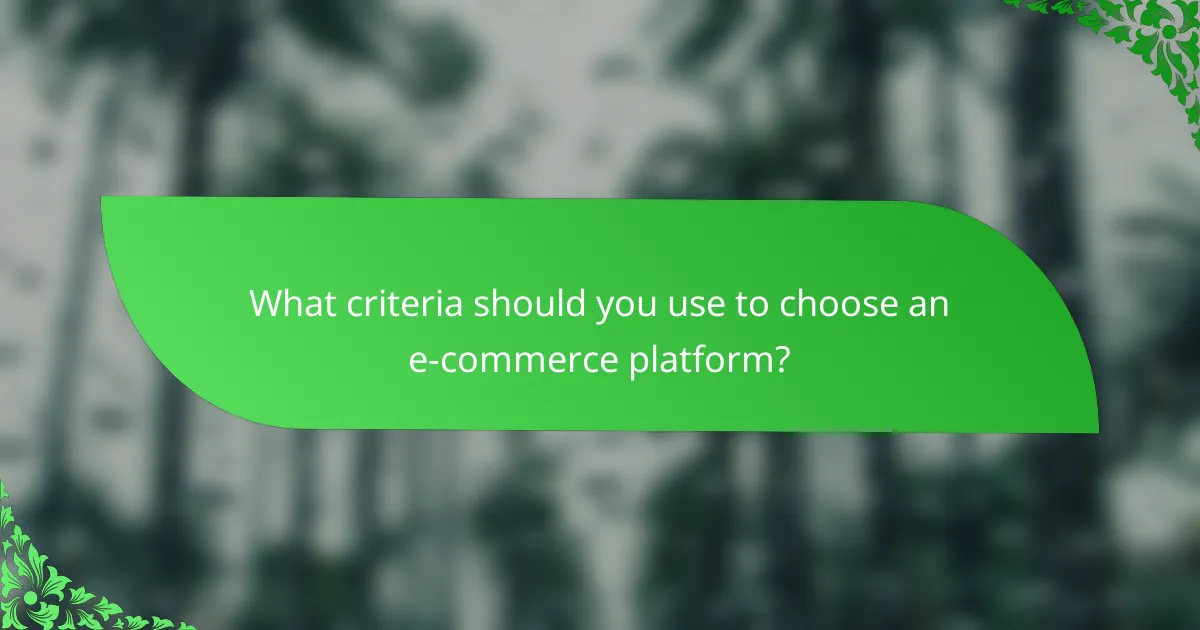E-commerce platforms like Shopify, WooCommerce, and BigCommerce provide small businesses with tailored solutions that effectively balance features, costs, and user experience. These platforms offer essential tools such as payment processing, inventory management, and customizable design templates, all designed to enhance online selling. Understanding the varying costs associated with these platforms is vital for making an informed choice that aligns with your business needs and budget.

Which e-commerce platforms are best for small businesses?
For small businesses, platforms like Shopify, WooCommerce, and BigCommerce offer tailored solutions that balance features, costs, and user experience. Choosing the right one depends on your specific needs, budget, and technical expertise.
Shopify features and pricing
Shopify is a user-friendly e-commerce platform that provides a comprehensive suite of features including customizable templates, payment processing, and inventory management. Pricing typically starts around $29 per month for the Basic plan, with additional costs for premium themes and apps.
Consider Shopify if you want a quick setup and a reliable support system. However, be mindful of transaction fees if you don’t use Shopify Payments, which can add to your overall costs.
WooCommerce flexibility and costs
WooCommerce is a plugin for WordPress that offers extensive customization options, making it ideal for businesses that want control over their online store. While the plugin itself is free, costs can arise from hosting, themes, and additional plugins, often totaling between $10 to $50 per month depending on your choices.
This platform is best for those familiar with WordPress and looking for flexibility. However, managing a WooCommerce store may require more technical knowledge compared to hosted solutions like Shopify.
BigCommerce scalability options
BigCommerce is designed for growth, offering robust features such as multi-channel selling and advanced SEO tools. Pricing starts at approximately $29.95 per month, with higher tiers available for businesses with larger sales volumes.
Choose BigCommerce if you anticipate rapid growth and need a platform that can scale with your business. Keep in mind that while it offers many built-in features, customization may be less intuitive than on other platforms.

What are the key features of top e-commerce platforms?
Top e-commerce platforms typically offer a range of essential features that enhance online selling. These include payment processing capabilities, inventory management tools, and user-friendly design templates, all aimed at streamlining operations and improving customer experience.
Payment processing capabilities
Effective payment processing is crucial for e-commerce success. Most platforms support multiple payment methods, including credit cards, digital wallets, and bank transfers, ensuring flexibility for customers. Look for features like PCI compliance, which protects sensitive payment information, and options for recurring billing if you offer subscription services.
Consider platforms that provide integrated payment gateways, as they simplify transactions and often reduce fees. Popular options include PayPal, Stripe, and Square, which can handle payments in various currencies, making them suitable for international sales.
Inventory management tools
Inventory management tools help you track stock levels, manage orders, and forecast demand. A robust system should allow real-time updates, automatic stock alerts, and integration with suppliers to streamline restocking processes. This is essential for preventing stockouts or overstock situations, which can negatively impact sales.
Some platforms offer advanced features like multi-channel inventory management, enabling you to sell across various marketplaces while keeping stock synchronized. This can save time and reduce errors, especially for businesses operating in multiple regions or countries.
User-friendly design templates
User-friendly design templates are vital for creating an appealing online store. Many e-commerce platforms provide customizable templates that cater to different industries, ensuring that your site looks professional without requiring extensive design skills. Look for responsive designs that work well on both desktop and mobile devices.
When choosing a template, consider the ease of navigation and the ability to showcase products effectively. Features like drag-and-drop editors can simplify the design process, allowing you to create a unique brand presence quickly. Additionally, ensure that templates are optimized for SEO to enhance visibility in search engines.

How do e-commerce platform costs compare?
E-commerce platform costs vary significantly based on features, transaction volumes, and subscription models. Understanding the different cost components is crucial for selecting the right platform for your business needs.
Monthly subscription fees
Monthly subscription fees for e-commerce platforms can range from low single digits to several hundred dollars, depending on the features offered. Basic plans typically start around $10 to $30 per month, while more advanced plans with additional tools and support can exceed $300 monthly.
When evaluating subscription fees, consider what features are included, such as website hosting, payment processing, and customer support. Some platforms may offer free trials or tiered pricing based on sales volume, which can help you choose the best option for your budget.
Transaction fees breakdown
Transaction fees are charges applied to each sale made through the platform, usually expressed as a percentage of the sale plus a fixed amount. These fees can range from about 1% to 5% per transaction, depending on the payment processor and the e-commerce platform.
Some platforms charge lower transaction fees for higher subscription tiers, while others may have flat fees regardless of the plan. Be sure to factor in these costs when calculating your overall expenses, as they can significantly impact your profit margins.
Hidden costs to consider
Hidden costs in e-commerce platforms can include payment gateway fees, add-on features, and third-party app integrations. These costs can add up quickly, so it’s essential to read the fine print and understand what is included in your subscription.
Additionally, consider potential costs for website design, custom development, and ongoing maintenance. Always budget for these extras to avoid surprises that could affect your bottom line.

What is the user experience like on popular e-commerce platforms?
The user experience on popular e-commerce platforms varies significantly, impacting how customers interact with online stores. Key factors include ease of navigation, design aesthetics, and overall functionality, which can influence conversion rates and customer satisfaction.
Shopify user interface analysis
Shopify is known for its intuitive user interface, which allows users to set up and manage their online stores with minimal technical expertise. The platform offers a drag-and-drop editor, making it easy to customize store layouts and add products.
Many users appreciate the clean design and mobile responsiveness of Shopify themes, which enhance the shopping experience. However, some may find the transaction fees on lower-tier plans a drawback, especially when using third-party payment gateways.
WooCommerce customer feedback
WooCommerce, as a WordPress plugin, provides a flexible and customizable experience, appealing to users who prefer more control over their online stores. Customer feedback often highlights the extensive range of plugins available, which can enhance functionality but may also lead to complexity.
Users frequently mention the learning curve associated with WooCommerce, particularly for those unfamiliar with WordPress. While many appreciate the lack of monthly fees, they note that hosting and maintenance costs can add up, impacting overall affordability.
BigCommerce usability ratings
BigCommerce generally receives positive usability ratings, particularly for its built-in features that cater to larger businesses. The platform’s user interface is designed to streamline the selling process, making it easier for users to manage inventory and analyze sales data.
However, some users report that the learning curve can be steep, especially for those transitioning from simpler platforms. BigCommerce’s pricing structure, which may include higher costs for advanced features, is another consideration for potential users evaluating their options.

What criteria should you use to choose an e-commerce platform?
Choosing an e-commerce platform requires careful consideration of several key criteria, including scalability, integration capabilities, user experience, and cost. These factors will significantly impact your online store’s performance and growth potential.
Scalability for future growth
Scalability is crucial for an e-commerce platform as it determines how well the system can handle increased traffic and sales as your business expands. Look for platforms that can support a growing product catalog and higher transaction volumes without compromising performance.
Consider platforms that offer flexible pricing plans or tiered features, allowing you to upgrade as needed. Some platforms may also provide built-in tools for inventory management and customer relationship management, which can be beneficial as your business scales.
Integration with third-party tools
Integration with third-party tools is essential for enhancing the functionality of your e-commerce platform. Look for platforms that easily connect with payment gateways, shipping services, and marketing tools to streamline operations and improve customer experience.
Evaluate the availability of APIs and plugins that can facilitate these integrations. A platform that supports popular tools like Google Analytics, Mailchimp, or social media advertising can significantly enhance your marketing efforts and operational efficiency.

How do e-commerce platforms support mobile commerce?
E-commerce platforms enhance mobile commerce by providing features that optimize the shopping experience on mobile devices. This includes mobile-responsive designs and various mobile payment options, which cater to the growing number of consumers shopping via smartphones and tablets.
Mobile-responsive design features
Mobile-responsive design ensures that e-commerce websites adapt seamlessly to different screen sizes, improving usability on smartphones and tablets. Key elements include flexible layouts, scalable images, and touch-friendly navigation, which collectively enhance the shopping experience.
When choosing an e-commerce platform, look for templates that are specifically designed for mobile use. Platforms like Shopify and WooCommerce offer themes that automatically adjust to mobile devices, ensuring that customers can easily browse and purchase products without frustration.
Mobile payment options
Mobile payment options are crucial for facilitating quick and secure transactions on e-commerce platforms. Popular methods include digital wallets like Apple Pay and Google Pay, as well as traditional credit card processing optimized for mobile use.
To maximize conversion rates, ensure that your e-commerce site supports multiple payment methods. Research shows that offering a variety of payment options can increase sales by appealing to different customer preferences. Additionally, prioritize security features to build trust with your customers during the checkout process.
